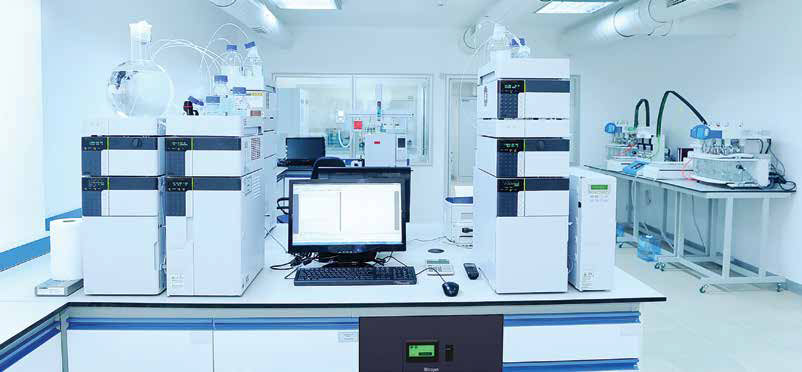Laboratory Gas Generators Keep Up with Increasing Demands for Cannabis Testing
Nitrogen and hydrogen gases are essential for different analytical techniques used to assess cannabis potency and safety
As cannabis legalization continues to take effect, there is an ever-increasing need for quality and potency testing. Cannabis exerts its effects through chemical compounds called cannabinoids, which act on receptors in the brain to alter neurotransmitter release. There are at least 104 cannabinoids that have been identified, with Δ9- tetrahydrocannabinol (Δ9-THC) and cannabidiol (CBD) being subject to the most scientific investigation. Potency testing involves quantification of Δ9-THC and CBD, and may also include terpene analysis. Terpenes are volatile unsaturated hydrocarbons that impart the unique aromas and mood effects associated with different cannabis strains. Given the variety of compounds present in cannabis, potency and terpene analysis is essential to provide consumers safe, consistent cannabis products. Gas and liquid chromatography are some of the most powerful, widely used techniques for cannabis analysis, and require a near-constant supply of highly pure nitrogen or hydrogen gas. Switching to a gas generator can reduce the cost and inconvenience associated with compressed gas cylinders and support cannabis testing with gas and liquid chromatography techniques.
Analytical Challenges
Gregory Ingle is the chief executive officer of Clinical Lab Consulting, based in Indianapolis, IN. The company has been helping set up mass spectrometry labs in the clinical laboratory space for more than seven years, and naturally segued into the cannabis market given the similar technology used for analysis. Using techniques including high performance liquid chromatography (HPLC), ultra high performance liquid chromatography (UHPLC), and gas chromatography (GC), often coupled with mass spectrometry (MS), they are able to complete cannabinoid potency testing, terpene profiling, as well as cannabis sample pesticide, residual solvent, and mycotoxin/ aflatoxin analysis.
Cannabis analysis is uniquely challenging, as products exist in many forms including plant matter, oils and concentrates, and even food products. “Scientifically, the largest challenge is in sample preparation. The products, especially edibles, have varying contents to be dealt with, so there is a lot of front-end work to get the sample ready to process,” explains Ingle. Proper preparation is critical to protect analytical instruments and produce accurate results, and many laboratories are working to optimize protocols for better analysis. In addition to methodological challenges, legal issues complicate cannabis testing. “The current regulatory environment, and especially the disconnect between state and federal law, is by far the most significant challenge associated with testing cannabis,” explains Dr. Brandon Canfield, associate professor of chemistry at Northern Michigan University.
Nitrogen and Hydrogen Requirements
A laboratory gas supply is necessary for chromatography techniques. Hydrogen gas is often used for GC, while nitrogen is more common in LC applications. “Hydrogen is used primarily by our GC-FID instruments, although there has been some discussion about converting to hydrogen carrier gas for all of our GC systems. If the switch was made to hydrogen carrier gas systems, a generator would be far more cost efficient,” says Canfield. “Nitrogen is primarily used by the LC-MS/MS instruments, which require 15-18 L/min each during standard operation.” Gas generators are an excellent solution for applications requiring a stable, continuous gas supply. “In mass spectrometry, your testing methods are the key to increased turnaround, faster throughput, and better analytical data. Having direct and consistent nitrogen flow is one of the major components to making all of it work in congruency,” explains Ingle.
 |  |  |  |  |
Improving Reliability, Reducing Costs, and Enhancing Safety
“In mass spectrometry, your testing methods are the key to increased turnaround, faster throughput, and better analytical data. Having direct and consistent nitrogen flow is one of the major components to making all of it work in congruency.”
A reliable gas supply is essential for analytical laboratories, especially those focused on cannabis sample analysis. “Customers are looking for reliability and ways to save money without cutting corners. The number one issue with any lab is downtime, as this can cost money, but in a very competitive industry, it can also cost future business,” explains David Russ, regional sales manager at Proton OnSite, a manufacturer of both nitrogen and hydrogen gas generators. Unfortunately for those relying on compressed gas cylinders or dewars as their sole gas supply, down time is a very real possibility. Running through a supply faster than anticipated, or cylinder delivery delays can bring analyses to a halt. “Cylinders are small and most facilities are equipped for storage of backup/empty cylinders; the liquid gas dewars on the other hand are quite large and not convenient to store. This leads to a regular situation where we are either sending back a dewar that is not yet empty because the new one has arrived and is ready to be swapped in, or we run the dewar to completely empty and then have to wait idly for the next delivery,” explains Canfield.
In addition to productivity losses, relying on compressed gas cylinders can be costly, as many suppliers charge tank rental, delivery, and environmental fees in addition to the cost of the gas itself. On-site nitrogen and hydrogen generators prevent unanticipated delays and are a more economical, long term solution. “Compressed cylinders aren’t cost effective and our methods utilize high back pressure that only a dedicated system can provide. We utilize the Proton OnSite N120M and N250M systems for their reliability, customer service, and support,” says Ingle.
Download the Cannabis Testing Lab Guide
Laboratory safety should always be a priority, and compressed gas cylinders necessitate many precautions. They are cumbersome, take up valuable laboratory space, must be properly secured and carefully handled during exchange. Generators offer a much safer alternative. “With a nitrogen generator, you remove the risk of having a cylinder or liquid dewar which contain large amounts of nitrogen at a very high pressure. Nitrogen generators use lower pressure coming out of the compressor, and there is no need to move the generator, so you’re removing that risk from the equation,” explains Russ. Generators are also compact, and can supply multiple areas within a laboratory, saving valuable floor space.
Solutions for Laboratories of All Sizes
When switching from compressed gas cylinders to a nitrogen or hydrogen generator, it is important to have a clear understanding of your laboratory’s needs, as there are numerous models to choose from. “The reality is one size does not fit all, and I think Proton does a great job of working with the customer to design a system that meets all of their needs, both today and in the future,” says Russ. As such, Proton OnSite generators are designed to support a wide range of analyses, from single instrument to multilab configurations. For labs that do not have access to a compressor or compressed air source, all-in-one systems equipped with internal, oil-free compressors offer a complete solution. For large laboratories with multiple LCMS systems, or multiple laboratories that require nitrogen or hydrogen gas, a lab server may be the best solution. A single lab server is a centralized on-site generator that serves multiple LCMS systems, and can be easily integrated into existing infrastructure to support multiple labs.

It is also important to ensure highly pure laboratory gases for cannabis testing and other precise analytical techniques. Generators eliminate a potential point of contamination associated with exchanging new and used gas cylinders. However, it is important to ensure a generator is equipped with technology that delivers high purity laboratory gases. Proton OnSite generators rely on pressure swing adsorption and membrane technology for nitrogen production and purification. Pressure swing adsorption uses carbon molecular sieves to separate nitrogen from other gases and contaminants. Membrane technology forces compressed air into a vessel that contains a hollow tube surrounded by a polymeric hollow fiber. The fibers are selectively permeable to oxygen, water vapor, and other impurities, and allow nitrogen to flow through the center, emerging as pure product. Proton On- Site hydrogen generators use Proton Exchange Membrane (PEM) water electrolysis to produce high purity hydrogen. This technology splits deionized water into hydrogen and oxygen on either side of a solid polymer electrolyte membrane. A DC voltage is applied to the electrolyzer to oxidize water, and the resulting protons pass through the PEM to the cathode and are reduced to hydrogen gas.
“Customers are looking for reliability and ways to save money without cutting corners. The number one issue with any lab is downtime, as this can cost money, but in a very competitive industry, it can also cost future business.”
As the cannabis industry continues to grow, many laboratories are tackling the challenges associated with potency, terpene, and contaminant testing. Gas and liquid chromatography, are powerful, widely used analytical techniques for cannabis testing, and ongoing efforts aim to optimize sample preparation and analysis protocols. High purity nitrogen and hydrogen gases are essential for these applications, and generators offer a safe, reliable, and cost-effective alternative to compressed gas cylinders. Proton OnSite offers expertise and products designed to meet the changing needs of analytical laboratories, for cannabis testing and beyond.
Application Note: Cannabis Pesticide Screening and Testing
| For more information on hydrogen and nitrogen gas generators, call 203.949.8697 or visit: www.ProtonOnSite.com |



